2020 Ford Mustang Shelby GT500 Review: Horsepower, Torque, and Tire Smoke
When Ford offers to put you behind the wheel of the 760 hp Shelby GT500, you of course say, “yes.”
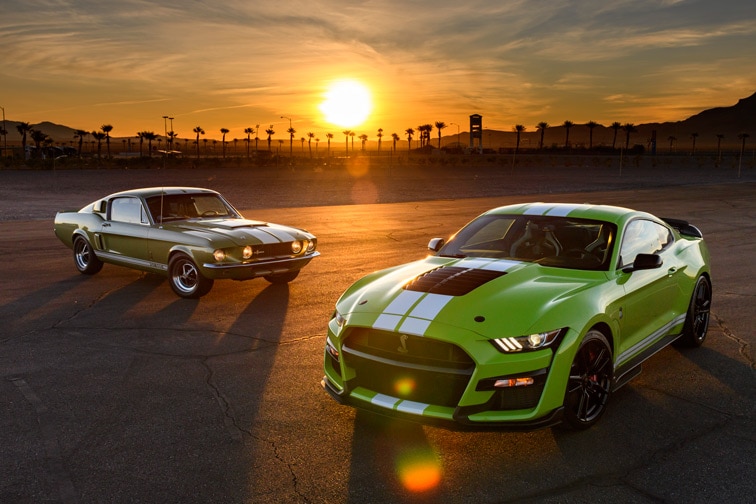 Courtesy of Ford
Courtesy of Ford
Carroll Shelby, the namesake of the Mustang Shelby GT500, dedicated much of his life to building and driving fast cars. He was successful as a professional race car driver years before developing his own brand of Mustang, and it shows. Driving a legendary 1967 Mustang Shelby GT500 down a long, lonely stretch of desert highway, the steering feels slack, the brakes mushy, and the cabin smells of era-appropriate (read: pre-pollution control) exhaust. It’s a serious machine, and it takes a real driving hero to keep a ‘60s-era Shelby GT500 rubber-side down.
In the right hands, however, it was a legend in its day.
So, when Ford offers to put you behind the wheel of the legend’s descendant, a 2020 Mustang Shelby GT500, you of course say, “yes.” The opportunity to experience the car on not just the road, but also a race track, and even a drag strip is a great way to see how Shelby’s old-school ethos plays out with modern technology.
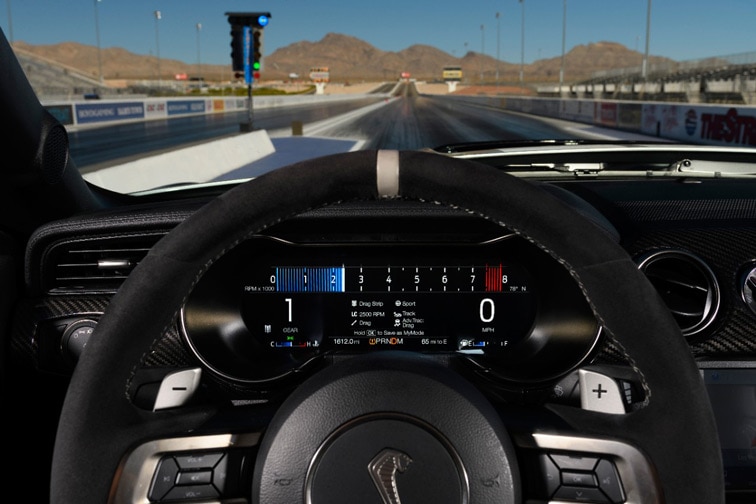 Ford
Ford
Anybody can drive the new Shelby GT500 quickly
As I prepare for my first trip down the drag strip, smoke billows from the new GT500’s massive, expensive, and chewing gum-soft tires that are destined for a short life. Ford says the 2020 GT500 is the most powerful street legal car in the company’s history, and that it can do a quarter-mile in 10.7 seconds—a feat more commonly associated with quarter-million dollar supercars.
I pull up to the starting line, engage launch control, and wait for the lights to glow green. After three runs, I earn an 11.18-second time slip. The GT500 just made a zero like me, who’d never drag raced before, look like a driving hero.
That’s the net effect of the more than fifty years of engineering and technology that separates the classic ’67 and the modern derivative. They’re both Mustangs with big engines, lots of power, and looks to match, but they’re otherwise nothing alike.
Anybody can drive the new Shelby GT500 quickly.
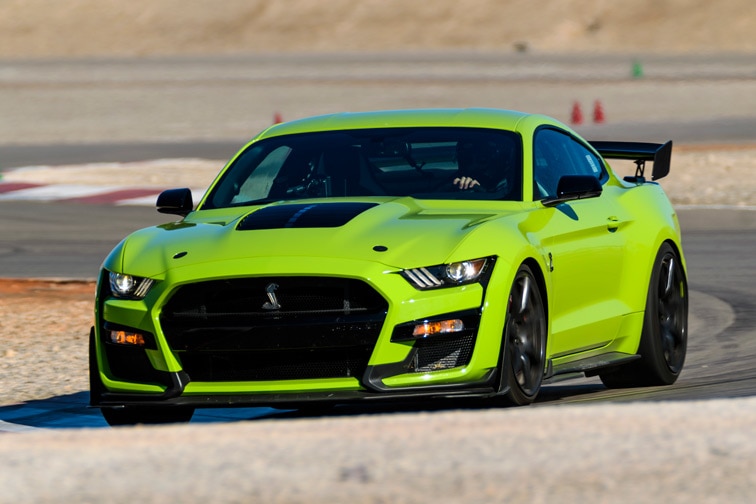 Ford
Ford
More than just a straight-line, one-trick pony
I’m about to run the Outside Road Course at Las Vegas Motor Speedway. But first, Ford’s arranged a “chalk talk” and van ride to prep me for the ride.
The Ford Transit’s being driven by one of the drivers from the Ford Chip Ganassi Racing Team—not exactly a stranger to powerful cars. His advice puts me on my heels, saying to floor it before I’m completely out of a corner, which is usually a recipe for disaster in a rear-wheel drive car with this much power.
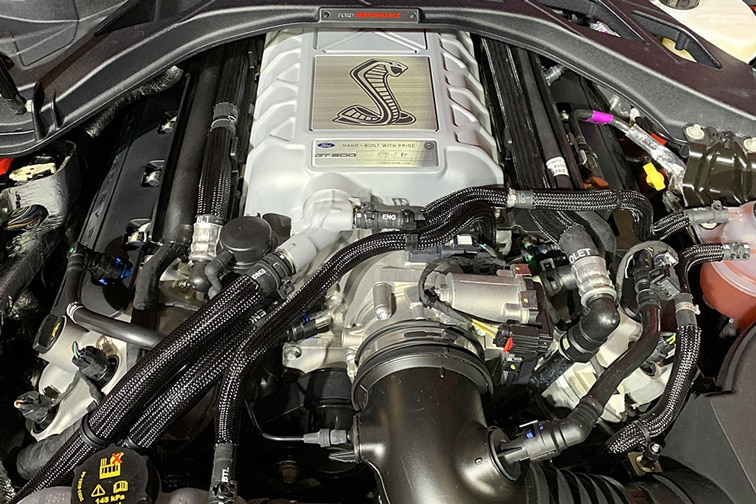 Christian Wardlaw
Christian Wardlaw
Equipped with a hand-built, supercharged, 5.2-liter V8 engine, the Shelby GT500 makes 760 horsepower and 625 lb.-ft. of torque. The engine’s a revver, peak power arriving at a lofty 7,300 rpm, with torque doing its thing at 5,000 rpm. And you can’t get a manual gearbox. Instead, there’s a 7-speed dual-clutch transmission with multiple driving modes and steering wheel paddle shifters.
Purists might complain, but I’m so focused on manning the machine—hauling it down from triple-digit speeds, safely hitting the correct points at each corner, and putting the power down smoothly—that I’m glad Ford ditched the clutch pedal. And in Track mode, the DCT is so good that I never used the paddles, either.
In addition to the powertrain, Ford engineers gave the entire car a performance massage ranging from massive brakes and structural improvements to engine cooling and oiling upgrades and a reworked suspension with MagneRide adaptive damping. A Handling Package ($1,500) adds a
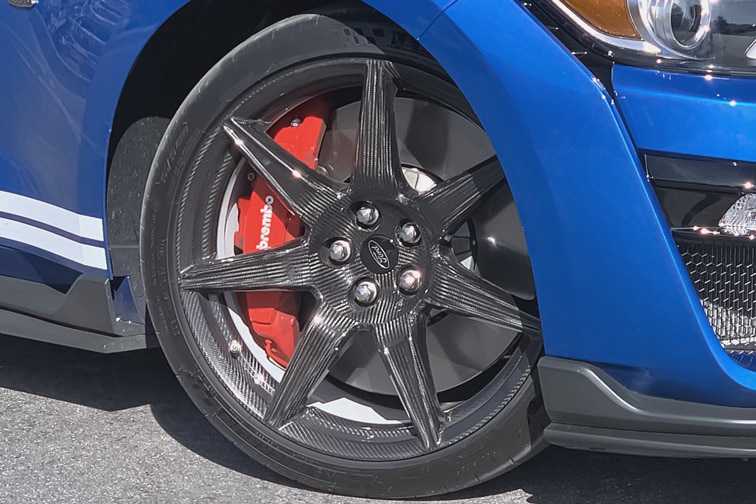 Christian Wardlaw
Christian Wardlaw
My track car has this package, and it inspires plenty of confidence. With each lap of the course, following the expert advice, but tempered with my own cautionary approach, I’m pushing harder on the accelerator pedal while exiting corners. The Mustang sticks no matter what, until my last lap.
Eager to get onto the back straight, I tromp down on the right pedal. That’s when the Shelby GT500’s rear end skitters a little bit. Some corrective steering input and the stability control work fast to keep the car aimed in the right direction. Almost immediately, the drama level lowers.
This was the only time that the car’s grippy tires became unglued from the pavement. Enter a tight corner too hot? No problem. Stab the gas to rocket down the front straight? Let’s do it. Toss the car through a quick left-right sequence while running up on the curbing? We’ve got this.
With the 2020 Mustang Shelby GT500, Ford has built a credible straight-line car, but it’s incredible on a road course.
 Christian Wardlaw
Christian Wardlaw
It’s loud, but there’s a “Quiet” mode
Most of the new Shelby GT500 fleet will never see a race track, and many won’t even venture onto the open road. Instead, they will sit, cherished under covers for decades, accumulating no miles at all. Still, these cars were built to rocket across the earth, so Ford let us cut loose on the Nevada Highway. After all, while it’s important to know what the Shelby GT500 can do on the track, what really matters is how it drives on the street. Of course, a rolling squadron of loud, brightly painted Mustangs meant one thing: Nevada’s finest were well aware of what was going on, so adhering to the speed limit was absolutely essential.
With the powertrain in Normal driving mode, the steering in Comfort mode, and the active exhaust in Quiet mode, the Shelby GT500 was as docile and well mannered as a typical Mustang you’d get at a rental counter. Equipped with the optional Recaro performance seats, it wasn’t terribly comfortable—the hard bottom bolsters digging into my thighs. And the aforementioned Carbon Fiber Track Package deletes the GT500’s back seat, creating an echo chamber for road, exhaust, and wind noise.
Visibility is equal to any other Mustang, which is to say better than some, but still not good. A blind spot monitoring system with rear cross-traffic alert is an option my test car didn’t have, but since everyone was passing me rather than the other way around, it wasn’t an issue.
The blind spot monitoring system is part of the Technology Package ($3,000), which also includes a power-adjustable driver’s seat, voice-activated navigation, a 12-speaker B&O Play sound system, heated outside mirrors, and LED courtesy lighting that projects a Cobra snake on the ground.
Other than the unyielding seat bolsters and loud-enough-you-need-to-yell road noise, the GT500 with the Carbon Fiber Track Package is easy to handle out in the real world. To drive it daily, the standard front seats and optional back seat are little creature comforts that can help you fully enjoy this snake’s charm.
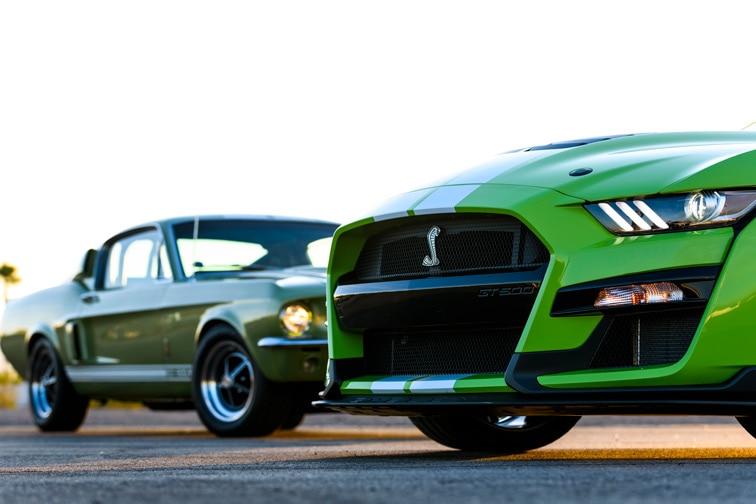 Ford
Ford
An Evolved Shelby, Grounded in a Legendary Past
I’ll never forget the ferocious racket the GT500 made roaring down the drag strip, the active exhaust in Track mode and ricocheting off the stands as I reached more than 130 mph in about the same amount of time that it took you to read this sentence.
In the decades since Carroll Shelby bestowed the original on the world, the GT500 has evolved, grounding it in a way that lets even amateur drivers partake in its glory. The new Shelby GT500 shines a light on the latest in American automotive engineering, while still celebrating the original spirit of its eponymous architect.
It may be simpler to keep rubber-side down, but the stories born from driving it are still the stuff of legends.
Key Vehicle Stats:
2020 Ford Mustang Shelby GT500
MSRP*:
Base: $72,900
As Tested: $92,775
Selected Specifications:
Fuel Economy (city/hwy/combined): 12/18/14
Power: 760 hp
Torque: 625 lb.-ft.
Seating Capacity: 4 (with optional rear seat installed)
Advanced Safety Systems:
Blind-spot monitoring with rear cross-traffic alert (optional)
911 Assist (Automatically contacts emergency responders following a collision)
*MSRP does not include $1,095 destination charge.
Written by humans.
Edited by humans.
 Christian Wardlaw
Christian WardlawMy first word was “car.” That’s what I’m told, anyway. For as long as I can remember, I’ve been obsessed with them. The design. The engineering. The performance. And the purpose. I’m a car enthusiast who loves to drive, but I’m also most interested in the cars, trucks, and SUVs that people actually buy. Anybody can tell you that a sports car is fast. What you need to know is whether or not you should buy that new SUV, and why. My life purpose is to help you make that decision.
Related articles
View more related articles